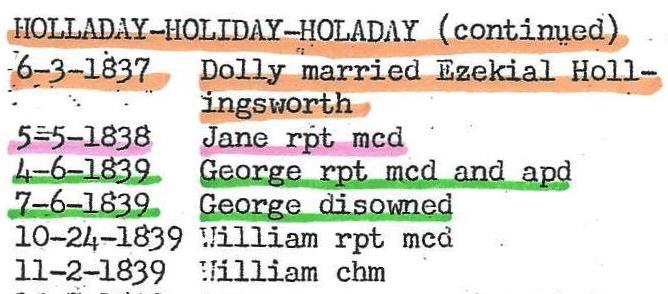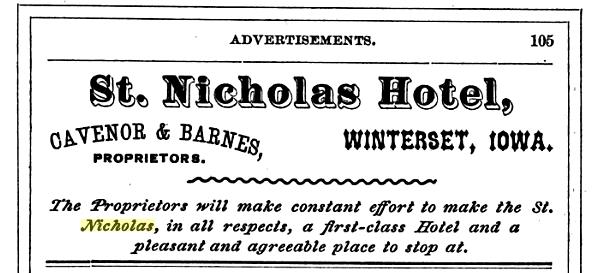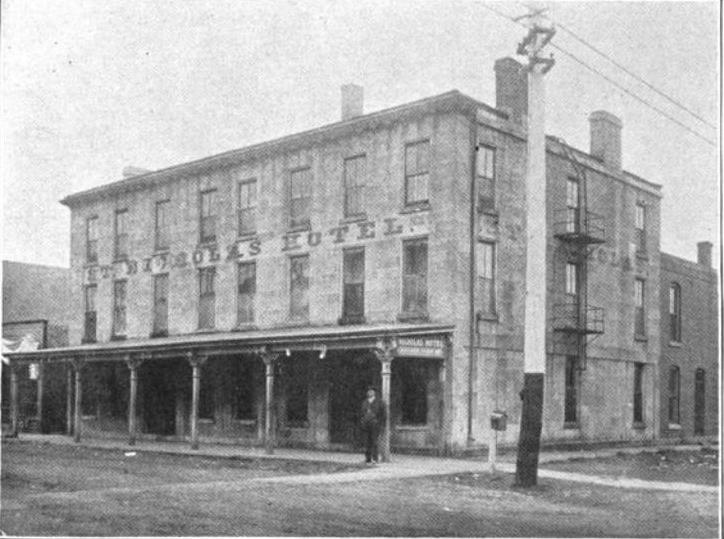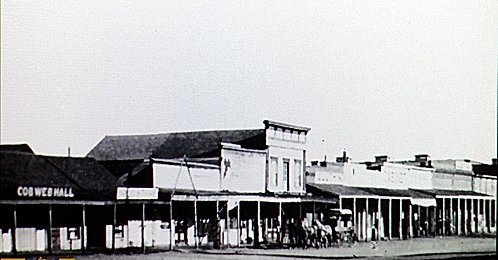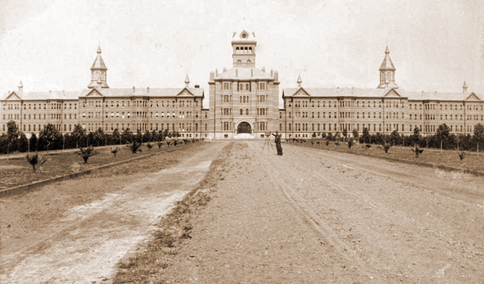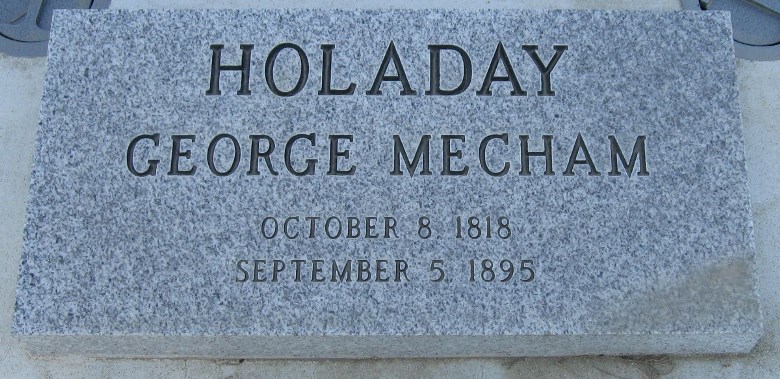George Meacham Holliday, 1818-1895 To say George was an interesting character would be a great understatement. :) When I began researching his history, I hit many roadblocks, and still do today. I try to just dig deeper. J George was my third great grandfather. I am impressed with George's accomplishments at the same time I am disappointed in his failures; namely the roaming nature of him that surely made life very difficult for his wife Lydia Hollingsworth. Lydia was a direct descendant of Valentine Hollingsworth, a founder of the Hollingsworth family in America circa 1682, in the time of William Penn. He was a prominent Quaker. For Lydia Hollingsworth's page, please click here. George, quite simply, could not seem to sit still. He always had his hand in something, whether it be a land purchase, a saloon or a great many other undertakings. Long before even George's birth, the "Holaday" name is used in various spellings. The Quaker records use various spellings as well, but often lumped them together. George, however, seemed to like to change his name often; or, the transcribers listed his name as they saw fit. When researching George, all of the following name configurations come up: First Name: George, G.M., George M., George Meacham, George Mecham: Last Name: Holaday, Holliday, Holiday, Holladay, Halliday. The first two are the most common. According to the 1894 Kern Co Voter Registration, George was 76 yrs of age, 5 ft 7.75 inches tall, light complexion, blue eyes, brown hair and blind in the left eye. Another census put him at 5 ft, 10 inches. I would be willing to be he was a handsome man. 1892 Voter CA Census:
~~~~~~~ George was born Oct 8, 1818 in Orange Co, IN to parents Samuel and Mary Dolly Meacham Holliday. His parents were married on March 28, 1814 in North Carolina. Circa 1817, the family made their way from Orange Co, NC to Orange Co, IN. They settled at Lick Creek and became members of the Lick Creek MM in Paoli, Orange Co, IN.
George's mother, (Mary) Dolly Meacham Holliday, was a very interesting woman in her own right. She was the daughter of George Meacham and Mary Dunham of North Carolina, who were buried in the Meacham Graves; Paoli, IN. Dolly’s siblings, Isaac and Ruth (McVey) were buried in the Old Paoli Cemetery. Meacham Graves -- From the Cemetery Records compiled by the Lost River Chapter DAR, Paoli Township Sec. 34 T. 2N.- R.1.W. Obliterated.
In 1828, Samuel, wife Dolly and children Polly, Jane, Sarah, Betsy, Asenath and George were received on certificate from the Lick Creek MM to the Vermilion Co, IL MM.
Mary Dolly became very involved in the Vermilion MM as well as visiting other Monthly Meetings. On April 1, 1837, Dolly announced her intent to marry Ezekiel Hollingsworth -- a very accomplished man in the MM's -- and! very interestingly, the father of Lydia Hollingsworth, who would later become George's wife soon after. Dolly and Ezekial married on June 3, 1837 at the Elwood MM House in Vermillion Co, IN. George and Lydia, as well as a brother of Lydia, Zebulon, were present as witnesses. So far, no death records for Samuel Holliday have been located but there is a mention of the fact that Dolly had become a widow: (Note the error in that it says: "Orange Co, IA" rather than "IN."
Ezekial Hollingsworth, father of Lydia and 2nd husband of Dolly, was born abt 1781 in Berkeley, SC. Ezekial's first wife, the mother of Lydia Hollingsworth, was Jane Hollingsworth; Ezekiel's first cousin. Jane died sometime before 1837. For more history on Ezekiel and Jane, please click here for my Lydia Hollingsworth page. The following appeared in The History of Vermilion Co, IL Vol I.:
Meanwhile, unfortunately, George found himself in trouble with the Quakers. In April 1839, George was reported for "marrying contrary to discipline" and "attending places of diversion." George and Lydia had wed in a civil ceremony in Vermilion Co, IL on November 29, 1838. He did not repent and he was disowned in July 1839. This is the last mention of him in any Quaker records. George's sister Jane had also married contrary to discipline and was disowned in October 1838. Marrying "contrary to discipline" was generally for one of two reasons. The first being the Quaker couple did not wish to go through the waiting period required by the Quakers, where an intent to marry must be made and the marriage must be approved, and in an effort to avoid this, instead married in a civil ceremony. The other reason was usually a pre-marital pregnancy.
George would never have made it as a Quaker, anyway, considering his future activities. For his wife, Lydia, however, it was a hard blow. From her obituary: "Her ancestors were a Quaker family, prominent in the history of Pennsylvania, Indiana, Illinois and Iowa as pioneers and nation builders. Born in the Friends’ faith, she was the greater part of her life unable to attend a church of her belief, yet she lived always according to its truest creedal spirit, being a deep and untiring reader of the Bible, and a searcher for its hidden and inspired meanings." On November 8, 1939, George and Lydia's first child of 11 children, Samuel, was born in Vermillion Co, IN. Incidentally, the spelling of Samuel's last name on Sons of the American Revolution paperwork is "Holaday." Samuel's headstone mistakenly reads, "Holiday." This is said to have been an error of the stonecutter. Circa 1840-1842, George and Lydia made their way to Henry Co, IA. Ezekial and Dolly had received a certificate to the Salem MM in Henry Co in August 1842. According to the grand-daughter of Jeremiah Hollingsworth, Lydia's brother, the entire family made their way from Vermilion Co to Keokuk Co. The family was said to consist of Ezekial, wife Dolly and twelve children and their families. They became members of the Friends Church at Rocky Run. Ezekial's first cabin was said to be a cross between hoopcabin and Indian bark hut. More children were born to George and Lydia: Miles, born in March 1842, and next John Milton, born 1843. An Iowa Census, 1844 lists George in Keokuk Co, IA. Caroline was born in 1845, twins Emma (Emily) and Ellen in 1846 and William in 1848. Also, an 1850 Census shows these family members as living in Keokuk Co.: George M, Lydia, Samuel, Miles, John Milton, Caroline, Emily, Ellen, William. Ezekial Hollingsworth, Lydia's father, died sometime before 1845, as we find Dolly remarrying on November 13, 1845 to Mahlon Stephenson Sr at the Bloomfield/Bloomingdale MM in Park Co, IN. What a sad thing for her that her 3rd husband died soon after, on January 15, 1846. Dolly suffered through the deaths of three husbands. I have lost track of Dolly beyond this time, though many records indicate she died in North Carolina. I cannot imagine how/why she would have returned to her birth state of North Carolina, but hopefully obtaining the Quaker records will shed some light here. George made land purchases circa 1847. 1850 began George's wanderlust time and he went westward for several years. He hardly sat still again until 1880. He seemed to appear only long enough to make more children, and he was off and running again. George must have been a man that exuded some power, charisma, charm. He surely did, for he found himself in positions of power and command in spite of being a disowned Quaker with no formal education. ~~~~~~~~~ From: An Illustrated History of Southern California detailing George's antics from 1850-1853:
From The Weekly Alta California, San Francisco, CA Vol V Issue 25, Pg 5, on Saturday, June 25, 1853:
It is very difficult to read, but the best I can decipher is this:
Sometime in 1852, it is said he also spent two months in Salt Lake City, UT and eight months in Sacramento, CA engaged in hotel business. The time frames are confusing. Apparently his troubles in California made him decide to come back to Iowa and the wife and children he had left behind. As of 1853, he is in Adair Co, IA and has purchased land. Lydia and children appear to have come to Adair Co at the same time, or possibly the next year. They settled in Jefferson Township, Adair Co, and located upon Section 26, where George built a double log cabin, which was said to have been the best house in the county at the time. In April of 1854, George was chosen as county judge at the cabin of Alfred Jones.
Other scans of some land purchases here. While acting as county judge, along with D.M. Valentine, the county surveyor, and Abram Rutt, the town of Fontanelle, IA was laid out. George established the Holaday Post Office in northeast Adair Co and operated it from 1855-1856 or so. George sowed the first wheat in 1854. The first oats were sown by George and John Febus in the spring of 1854; the former on Section 35 and the latter on Section 27. George performed the first marriage in the county on May 7, 1854 at the residence of William Alcorn, between William Stinson and Elizabeth F. Crow. The first election was held at the house of George Holaday on Section 35 in 1855.
George and Lydia's next child was the first birth in Jefferson Township. Thomas Jefferson Holaday was born in the fall of 1854, but unfortunately died the following year, in the autumn of 1855. He is said to be buried in a pasture in Section 26 of Jefferson Township. He was buried with another child, William Alcorn, who was 7 or 8 years old when he died in 1853 of a rattlesnake bite. William was the first death in the county. The next child appears to be Orpha Holaday, born about 1856. She appears on the 1856 Iowa Census in Adair Co as being "0" years old. Pauline, the next child, was born on June 19, 1856, so surely Orpha and Pauline were born nearly back to back. I've wondered if perhaps the girls were twins, but Pauline does not appear on the 1856 Census. Pauline appears on the 1860 Federal Census, though her name is partially crossed out and somewhat illegible. It was transcribed as "Palmer," but this is surely Pauline. She is listed as 3 years old and female on the 1860 census. Orpha disappears on the 1860 Census, so she has apparently died by then. From Lydia's Obituary: "Of the eleven children born to Mrs. Holaday two died in infancy..." These two children are Thomas Jefferson and Orpha. Sometime also circa 1856, George was off and running again, this time to Ft. Des Moines, IA, supposedly to educate his children. Lydia was said to be agreeable to this. A write up in the History of Guthrie and Adair Counties, IA, 1884, transcribed by Bobbi Pohl, states: "In the fall of 1856 he left here for Des Moines, wither he went to educate his children. He did not turn out well, leaving his wife and children to shift for themselves, and left this country with another woman. He is believed to be in California at the present time....." It is not known which children may have gone to Ft Des Moines with George. While at Ft Des Moines, George is said to have been a Justice of the Peace from 1857-1858, but I have not found any records that can confirm this for certain. As for leaving "this country" with another woman -- I will attempt to address this a bit later. In 1859 George returned to Winterset and apparently got busy right away and his last child, Henry Delano, was born on April 10, 1860. All of the children, as well as George, appear on the 1860 US Federal Census at Winterset, Madison Co, minus Orpha. What is questionable is when did Lydia go to Winterset? Did she go there in 1856, when George left for Ft Des Moines? Did she wait in Jefferson Township until he came back and they both went to Winterset? It will likely not be known. It would be nice to know, as it would shed a clue on where poor Miss Orpha may have been buried. For now, it is a toss-up between Jefferson Township, perhaps alongside her brother Thomas Jefferson, or in Winterset City Cemetery. What a sad thing that Lydia had lost two young children so close together, and her husband leaves her there to pick up the pieces. In 1856, Judge Pitzer built a hotel in Winterset, which was initially named "Pitzer House." George and Lydia appear in Winterset circa 1859 and sometime soon after their arrival, they were running the hotel, which had been renamed, "The St Nicholas." Lydia would later run the hotel by herself for a time. It is said at one time George and Lydia owned the hotel, but I cannot confirm this.
The man standing in front of the hotel is unidentified. It could be Judge Pitzer, it could be George Holliday -- it could be many different men. George and Lydia's daughter Caroline, in a 1908 writing referred to the St Nicholas as a "tavern." An excerpt from her writing:
George's presence did not last long. He left in 1860 on a mining expedition to Pike's Peak. It is said he was involved in running a freight line between Omaha, NE and Denver, CO for a few years. An as yet undetermined possible relative, Ben Holladay, owned "The Western Stage Company" and had a mail contract awarded to him on September 20, 1860 to run mail between Omaha and Ft Kearney, NE and Denver, CO. Passenger service to mining camps was added later. It is very likely George had a tie to Ben Holladay and worked for him. Additionally, Ben Holladay operated several lines that ran to Utah, Montana, Washington and Oregon. Eventually Wells Fargo purchased Ben Holladay's holdings. By 1863, George is running a whiskey mill and boarding house in Prescott, AZ. Very likely, it was at Old Whiskey Row:
Whiskey Row runs north and south on S. Montezuma St. between Gurley and Goodwin St., directly west of the county courthouse. This single city block has been the home of the St. Michael's Hotel and the Palace Hotel since the late 19th century along with other colorful purveyors of night-life. George does not disappoint. Kicked out of the Quakers in part for "attending places of diversion," I suppose him ending up here is not particularly surprising. George liked hotels, taverns and bars. In 1864, an Arizona Census shows George in Arizona Co, La Paz township. While here, he was a member of the House of Representatives in the 1st Arizona Territorial Legislature. How, oh how, did George obtain such a position one must wonder! He is listed as: George M. Holaday, La Paz, AZ, Hotel Keeper, 46 years of age, born in Indiana. By 1867, George was moving on, this time to Sonoma Co, CA, where he kept a hotel and bar for six months. In 1868, George is in Orange Co, CA. Southern California history says George had been Justice of the Peace for several terms. (unconfirmed) Also in 1868, George marries again. I do not believe George ever divorced Lydia; he simply left her. Marriage records show George married Mary E Robinson in San Francisco, CA. Some records say she was a native of Missouri and her father was Erwin Robinson. Later census reports show her last name, as well as that of some of her children, as "Finley" and her birth state of Tennessee. She had, then, apparently been married before, but thus far, no records have been found relating to her prior marriage. Later census reports are very curious in regard to Mary Finley. This is where I am going to take some liberties and make some suppositions that may have no merit whatsoever! :) An 1870 Census of San Jose Co, Los Angeles, CA shows George is living with Mary and children:
What is interesting here is the birthplace shown for "George W," 11 years old, birth state IOWA, born approximately 1859. George Sr. was between Ft Des Moines and Winterset at that time. Could he have met Mary Finley at Ft Des Moines to have this child? Too bad this census doesn't show relationships as the next one does. George and Lydia did not have any children named George. There is no mention of George taking any of his children once he permanently left Iowa around 1860. There is also the mention in the History of Guthrie and Adair Counties, 1884, that George "left the country" (did they mean county?) "with another woman." One reference also referred to the woman George left with as a "hired girl." Was this Mary??? In 1872 George was buying up land in Rancho Las Bolsas tract. It included Fountain Valley, CA and is present day Orange Co, CA. In 1879 he purchased a ranch in the tract of the Westminster colony, Westminster, CA, which is present day Orange Co also. In the 1880 US Federal Census, San Jose Co, Los Angeles, CA Census, we see this:
George and James are listed this time as "Finley" and as stepsons. For whatever reason, the younger George now has a "W" as a middle initial. That had been on the elder George's census the decade before. The older George has apparently left by 1880, as he would have been 21 years of age by then. Dilla has apparently left as well, as she would have been 21 also. Amanda now appears as a "boarder" so she must have married *unk* Avis and is living with George and Mary. The entire page is here, where you can see birth locations:
This shows both the stepsons' birthplaces as Oregon. It also shows Mary's birthplace, as well as her parents' birthplaces, as Tennessee. This contraindicates other research, which says she was a native of Missouri. Oh the mysteries! :) Birth years for Mary Finley's children are approximately: 1857 Birth of Amanda Finley; California 1859 Birth George W Finley; Iowa 1860 Birth of Dilla Finley; Oregon 1861 Birth of James Finley; Oregon 1863 Birth of George Finley; California It would seem that Mary Robinson Finley moved around a bit as well. To make matters more interesting, a future record indicates Mary actually had a total of 8 children, of whom 3 were supposedly still living in 1900. ~~~~~~~~~~~~ Mary's life did not end well. Mary is found in 1900 as an "inmate" of the St Agnews State Hospital (Insane Asylum) in Santa Clara, CA. Note the "Halliday" spelling. She is listed as 67 years old, married and born in 1837. The "married" indication is curious, as George had died in 1895. Perhaps when she was committed, he was still alive. Or, perhaps, it is the wrong Mary altogether.... Time and far more research will hopefully answer this mystery. Did George drive this poor woman to insanity? In the write up on George in the History of Southern California, 1890, they wrote this about him: "He is a member of the Holiness Church and an earnest Christian gentleman. He has been a wanderer for many years, but is now settled in a quiet home, where he expects to spend the evening of life, free from the rush and excitement of a public career, etc." A wanderer, yes indeed. An earnest Christian gentleman? The jury is out. St Agnews "Inmate" Census, 1900:
St Agnews before the quake of 1906
The hospital was severely damaged in the quake of 1906 and many inmates perished. Others escaped. Some family trees put her death year as 1915, but is for now, unknown. ~~~~~~~~~~ As for George Sr, he died in Tulare, CA on September 5, 1895. He had moved to Tulare sometime after 1892 to be closer to his son, Miles. This makes one believe Mary had been committed to St Agnews by then and George was alone. Miles shows as a resident of Tulare in 1900 and died circa 1916. George is buried in the Tulare City Cemetery. Note the misspelling of his middle name - (his mother's maiden name.)
For all my research and work, I have yet to find a single photo of George Meacham Holliday. I have found what I consider little information for a man who was involved in a great many things. I don't know why this may be -- perhaps I am looking in the wrong places. I also wonder if George wasn't, quite honestly, something of a scoundrel and that is perhaps why he wasn't more publicly acknowledged. ~~~~~~~ Back in Iowa, Lydia remained in Winterset for her entire life. Her husband left her just before the Civil War broke out, and it is unimaginable what it must have been like for her, to raise her children with no assistance in the middle of war times. George & Lydia's daughter Caroline wrote a beautiful piece in 1908 about life during Civil War times in Madison County. An exceptionally beautiful passage:
I have read this passage repeatedly. Any mother of any child in danger's way would be able to relate to this -- it is truly timeless. Lydia lived with her daughter Caroline for many years after Caroline's husband, Benjamin Franklin Murray, died 1890. Cemetery records indicate "senility" as a cause of death, but Lydia had indeed reached the ripe old age of 92. Had I endured all that Lydia had, I surely would have been senile long before that. I have immense respect for Lydia. She endured great hardships and did so alone for so many of her years. As I research, Lydia is always on my mind, as is her baby daughter Orpha, in particular. Although she was born more than 150 years before me, she is alive in my heart and soul. This page, really, is more about Lydia than her husband George, in many respects. I want to honor her, her hardships and trials far more than I want to trace George's footsteps. As I type this now, on my Windows 7 computer and prepare to put it on the Internet in 2013, I think of Caroline's closing comments in her piece....
...and I wish there was a way to say to her -- "Yes, it is difficult, but 105 years later, we are reading your eloquent words and we are exceedingly grateful that you put them to paper and... we... truly and deeply care." RIP. Names and Dates George Meacham Holliday and Lydia had the following children: Samuel L Holaday 1839 – 1906 Miles Holaday 1842 – 1916 John Milton Holaday 1843 – 1927 Caroline Holaday 1845 – 1918 Emma Emily C Holaday 1846 – 1918 Ellen Holaday 1846 – 1881 William Holaday 1848 – 1931 Thomas Jefferson Holaday 1854 – 1855 Pauline Holaday 1856 – 1936 Orpha Holaday 1856 – 1856 Henry Delano Holaday 1860 – 1924 Ezekiel Hollingsworth, father of Lydia Ezekial was the son of Joseph Hollingsworth 1735 – 1792 and Margaret Hammer Wright 1742 – 1822. Joseph Hollingsworth was the son of George Henry Hollingsworth 1712 – 1786 and Hannah McKay McCoy 1718 – 1753 George Henry was the son of Abraham Hollingsworth 1686 – 1748 and Ann Robinson 1689 – 1749 Abraham was the son of Thomas Valentine Hollingsworth 1661 – 1727 and Margaret Calvert 1661 – 1687 Thomas Valentine was the son of Valentine Hollingsworth 1632 – 1710 and Ann Ree 1628 – 1671 (b) (m) Jane Hollingsworth (b) (d) (d) Jane Hollingsworth was the dau of George Hollingsworth 1762 – 1823 and Jane Henry 1765 – George was the son of George Henry Hollingsworth 1712 – 1786 and Jane Elwell 1720 – 1795 George Henry was the son of Abraham Hollingsworth 1686 – 1748 and Ann Robinson 1689 – 1749 Abraham was the son of Thomas Valentine Hollingsworth 1661 – 1727 and Margaret Calvert 1661 – 1687 Thomas Valentine was the son of Valentine Hollingsworth 1632 – 1710 and Ann Ree 1628 – 1671 Ezekial and Jane had the following children: Zebulon Hollingsworth 1804 – ? (m) Eliza Karr 15 Apr 1834 and had the following children: Elbert Hollingsworth 1835 – 1920 Rebecca J Hollingsworth 1837 – 1921 Mahundra Hollingsworth 1847 – 1909 Miles Hollingsworth 1808 – Jeremiah Hollingsworth Hon 1809 – 1887 (m) Catherine Amos 1806 – 1889 and had the following children: John W. Hollingsworth 1848 – Mahondra Hollingsworth 1810 – Mary Hollingsworth 1812 – Cynthia Hollingsworth 1813 – 1873 John Hollingsworth 1816 – William Hollingsworth Dr 1818 – Lydia Hollingsworth 1819 – 1911 Elias Hollingsworth 1824 – Ruth Jane Hollingsworth 1825 – 1915 Eliza Hollingsworth 1825 – Ezekial's 2nd wife, Mary Dolly Meacham Holliday Mary Dolly was the dau of George Meacham (b) (d) and Mary Dunham (b) (d) (b) (m) (d) Mary's first husband was Samuel Holliday (b) (d) Samuel and Mary had the following children: William Holaday 1816 – 1880 George Meacham Holliday 1818 – 1895 Mary Jane Holliday 1821 – Sarah Holliday 1822 – 1866 Asenath Holliday 1824 – 1866 Find a grave links:BF Murray http://www.findagrave.com/cgi-bin/fg.cgi?page=gr&GRid=13086904 Lydia http://www.findagrave.com/cgi-bin/fg.cgi?page=gr&GSvcid=398825&GRid=13086887& Lydia's son William http://www.findagrave.com/cgi-bin/fg.cgi?page=gr&GRid=67624922 Orpha http://www.findagrave.com/cgi-bin/fg.cgi?page=gr&GRid=114189206 Other References and Links: |
||


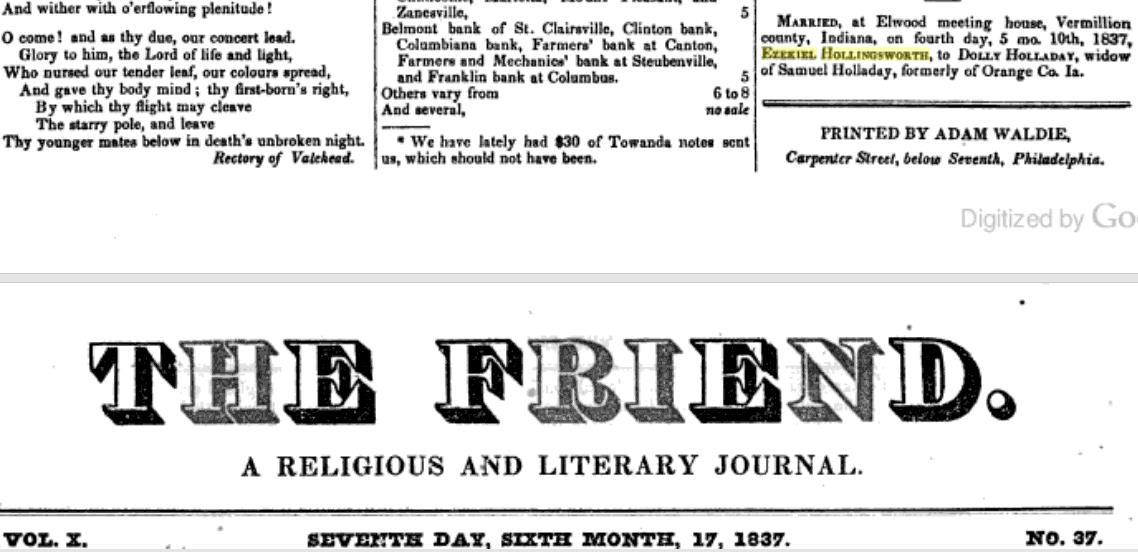 j
j
